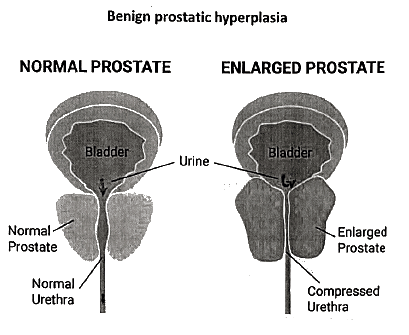Prostate Gland: Miscellaneous | Medical Science Optional Notes for UPSC PDF Download
Prostate gland-Gross Anatomy
The prostate is a fibromuscular gland shaped like a pyramid, enveloping the prostatic urethra from the base of the bladder to the membranous urethra. Positioned at a lower level within the lesser pelvis, it rests behind the inferior edge of the symphysis pubis and the pubic arch, and it is anterior to both the rectourethralis and the rectal ampulla, allowing for palpation. With a somewhat pyramidal structure, it exhibits a superior base or vesical aspect, an inferior apex, and posterior, anterior, as well as two inferolateral surfaces.

The prostate is penetrated by the urethra and ejaculatory ducts, housing the prostatic utricle.
Zonal Anatomy of Prostate gland
 Adenomatous zone includes central and transitional zones
Adenomatous zone includes central and transitional zones
The cup-shaped peripheral zone encompasses the central transitional zone and the preprostatic urethra, excluding the anterior portion, making up 70% of the volume. This zone is where the majority of carcinomas originate.

The central zone envelops the ejaculatory ducts, situated posteriorly to the preprostatic urethra, forming a somewhat conical shape with its apex at the verumontanum. This zone constitutes 25% of the volume and occupies the space between the peripheral zones anterior to the preprostatic urethra.
The transitional zone surrounds the distal part of the preprostatic urethra, positioned just proximal to the apex of the central zone and the ejaculatory ducts. This zone, making up 5% of the volume, is affected by benign prostatic hyperplasia (BPH).
Lobes of Prostate gland
Initially, the prostate gland was believed to be categorized into five anatomical lobes; however, it is now acknowledged that distinguishing five lobes is only feasible in the fetal gland before 20 weeks of gestation. From that point until the onset of benign prostatic hyperplasia (BPH), only three lobes are discernible, comprising two lateral lobes and a median lobe.

Prostate gland-Blood supply and lymphatic drainage
The prostate receives its blood supply from branches of the inferior vesical, internal pudendal, and middle rectal arteries. The veins form a plexus, with the primary tributary being the deep dorsal vein of the penis. Additionally, the plexus receives anterior vesical and prostatic rami (connecting with the vesical plexus and internal pudendal vein) and ultimately drains into the vesical and internal iliac veins.
Lymphatic drainage
The vessels of the prostate primarily terminate in the internal iliac, sacral, and obturator nodes.
 |
Download the notes
Prostate Gland: Miscellaneous
|
Download as PDF |
BPH
Manifesting in males aged 50 and older, benign prostatic hyperplasia (BPH) is prevalent, with 50% of men exhibiting histological evidence of BPH by the age of 60. This condition often leads to notable lower urinary tract symptoms and stands as the primary cause of bladder outflow obstruction in men over 70 years old. BPH typically impacts the submucous glands in the transitional zone, resulting in nodular enlargement.

Prostate gland - Repeats
Describe the zones and lobes of prostate gland. Add a note on applied anatomy of benign prostatic hypertrophy. (2014)
|
7 videos|219 docs
|
FAQs on Prostate Gland: Miscellaneous - Medical Science Optional Notes for UPSC
| 1. What is the gross anatomy of the prostate gland? |  |
| 2. What is the zonal anatomy of the prostate gland? |  |
| 3. What are the lobes of the prostate gland? |  |
| 4. What is the importance of understanding the gross anatomy of the prostate gland? |  |
| 5. What are some common disorders or diseases associated with the prostate gland? |  |






















